How To Clean Guitar Fretboard? – Essential Tips
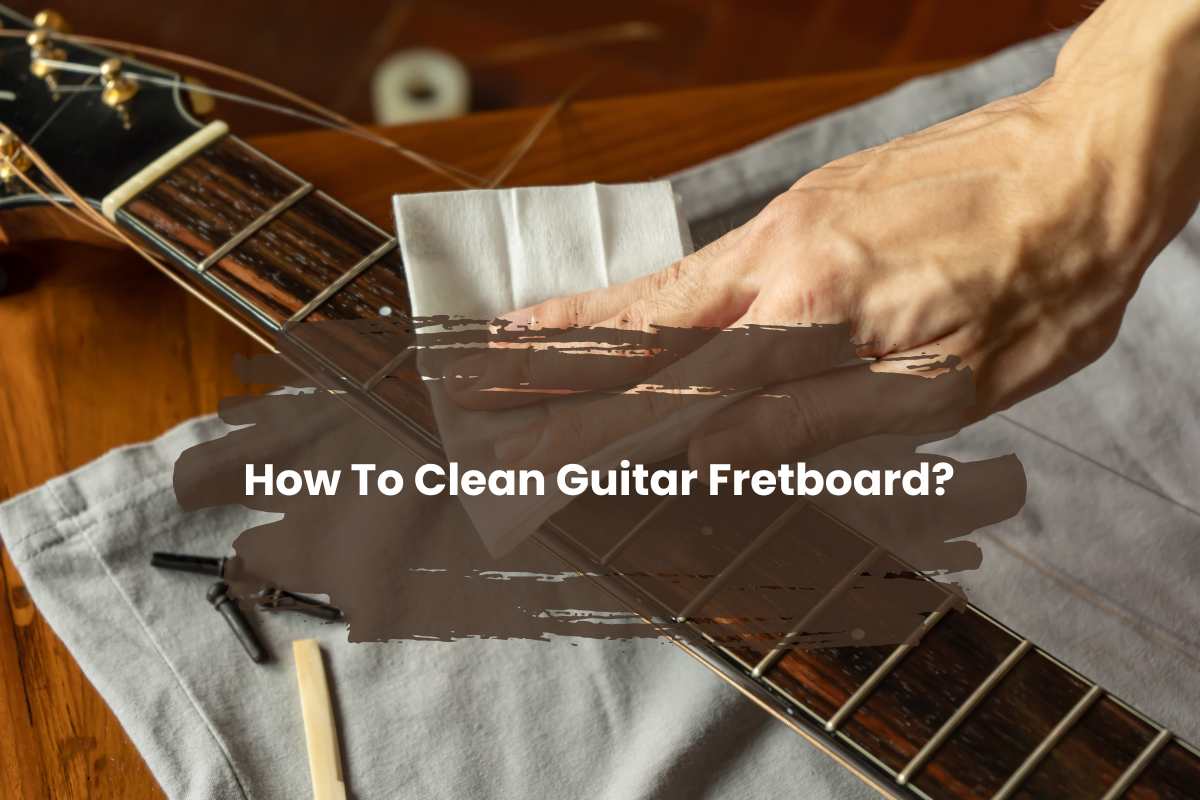
Fretboard has some serious duties. It’s there on the guitar neck and changes–
- Vibrating length and
- Pitch of notes
You get the right tone as long as the fretboard is ‘fit as a fiddle’. Sadly, over time, the part can get dirty and alter the whole properties– from physical to tonal.
How do they get dirty?
Blame– dust particles, grease, oil, sweat, dead skin cells, etc.
Fret not!
Because with a few products and techniques, you can wipe them all away!
How do you clean it?
Simple– use a little bit of cleaner on the cloth and clean the fretboard well with it. Depending on the materials, the fretboard may request conditioning with lemon oil as well.
You may have several questions to ask now!
- What cleaner?
- Why should I condition my fretboard and which conditioner to use?
- What are the proper steps?
- How do I know if my fretboard needs cleaning?
- How often?
Let’s walk you through the process of cleaning the fretboard and take you to all the answers!
Key Takeaways: Guitar Fretboard Cleaning
- Cleaning enhances the performance, tone, strength, and aesthetics of the fretboard.
- Fretboard commonly comes in materials like ebony, maple, and rosewood.
- Dirt, oils, sweat, and dead skin cells can cause the fretboard to become dirty.
- The finished fretboard needs a cleaner.
- The unfinished fretboard needs both cleaner and conditioner.
- Lemon oil can be a powerful combination of cleaner and conditioner.
- Try to clean the fretboard at least 2 to 3 times a year.
Understanding Fretboard Types and Their Cleaning Needs
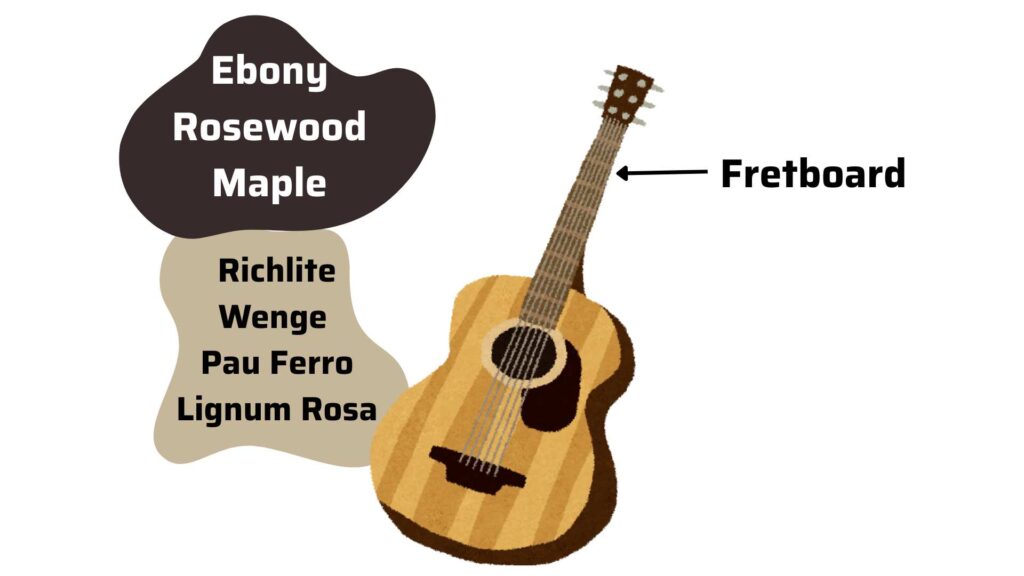
Guitar fretboard comes in different forms. You can categorize them into materials.
The Big Three Fretboard Woods are usually
- Ebony
- Rosewood
- Maple
Some other popular ones are
- Richlite
- Wenge
- Pau Ferro
- Lignum Rosa
Unfinished fretboards like Ebony and Rosewood require distinct cleaning methods. You can clean them and then condition them.
Such materials dry out easily. Hence, conditioning helps nourish the wood and prevent that.
Finish fretboards like Maple and Richlite will be happy to be cleaned. It’s because they already maintain moisture.
You’ll just need to clean the fretboard to remove surface grime without damaging the protective finish.
Learn about the difference between Maple Vs Rosewood Fretboard here.
| Fretboard Type | Finish Type | Cleaning Method | Durability |
| Ebony | Unfinished | Lemon oil/ conditioner | Long lasting but can darken |
| Rosewood | Unfinished | Lemon oil/ conditioner | Long lasting but can dry out |
| Maple | Finished | Mild guitar-safe cleaner | Very durable but can wear out if not well-maintained |
| Richlite | Finished | Mild guitar-safe cleaner | Durable but can wear out if not well-maintained |
| Wenge | Unfinished | Lemon oil/ conditioner | Durable but can crack if not well-maintained |
| Pau Ferro | Unfinished | Lemon oil/ conditioner | Very durable but can crack if not well-maintained |
| Lignum Rosa | Unfinished | Lemon oil/ conditioner | Durable but can crack if not well-maintained |
Why Is Cleaning Your Guitar Fretboard Important?
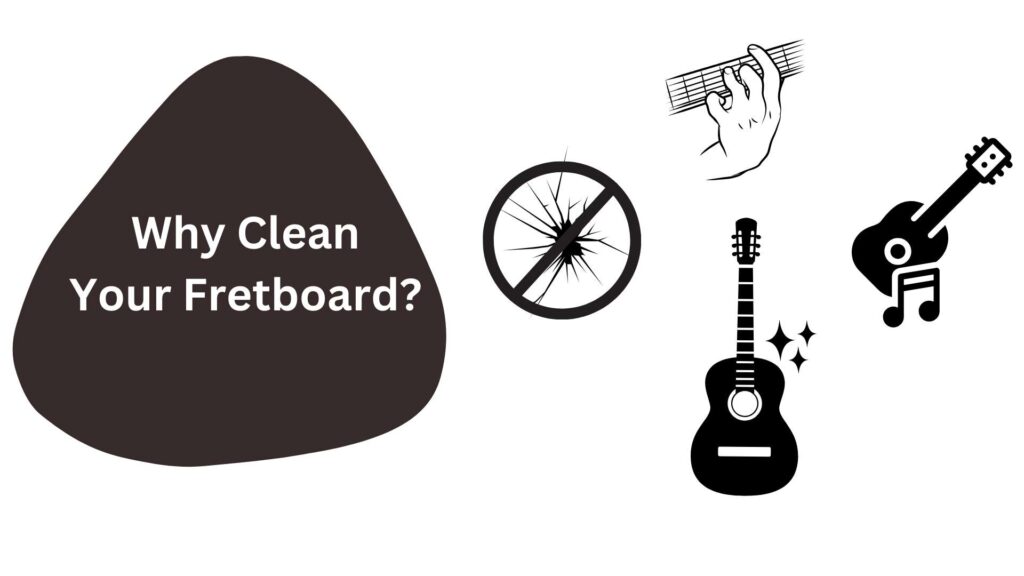
Prevents Damage
Grime and grease– both can build up on the fretboard over time.
This can easily cause issues like structural weakening, warping, and discoloration. Eventually, it damages the wood.
However, regular cleaning removes all the reasons that lead to damage. It takes off debris and other buildups through gentle cleaning agents.
Moreover, it prolongs the life of the fretboard.
Improves Playability
Dirt and debris can create friction when you try to play.
They form a rough layer and gritty texture on the fretboard wood surface. This causes your fingers to drag or stick. Consequently, it gets hard to move your fingers across the frets.
Cleaning will help smoothen the surface. Plus, it lets your fingers slide smoothly along the neck. This makes it easier to play and reduces friction.
Enhances Tone Quality
Dirt, oils, and moisture—
They can dampen the natural vibration your fretboard wood releases. This ends up affecting the sound quality. You may face issues like–
- Buzzing strings
- Out of tune
- No sound at all
However, a clean fretboard makes sure it doesn’t happen. Instead, it allows for a smoother sound transmission, which enhances your guitar’s tone quality.
Cleaning the fretboard also helps the guitar produce clearer and more resonant notes.
Maintains Appearance
Dirty fretboards can never look appealing. They won’t even excite you to touch the guitar and play it.
Hence cleaning them is a must. It helps maintain the guitar’s polished look and value. Not just that! You won’t face problems like stains or discoloration.
Moreover, a well-care-for instrument can also fetch a high resale price if you ever decide to trade it.
Prevents Fret Corrosion
Buildup dirt can wear out frets faster. They get corroded over time because of the oils and sweat transferring from your fingers.
So, if you don’t clean them regularly, the frets can start to rust.
Cleaning the fretboard will prevent that. It’ll remove harmful substances and keep your guitar free of damage.
What Makes Your Guitar Fretboard Dirty?
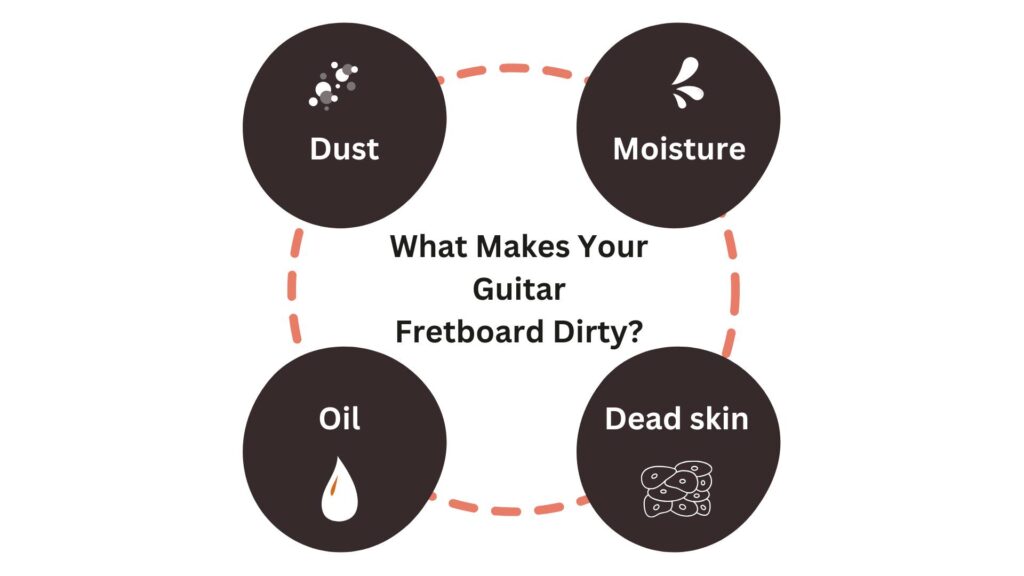
Dirt and Grime
Dust particles wander around along with the air freely. When the guitar is exposed to elements, the dust easily sits on the surface and makes it dirty.
Moreover, your fingers can be a source too.
As you play, dirt and sweat from the fingers or hands get on the fretboard. This grime builds up over time and makes the surfaces sticky. Eventually, the guitar feels harder to play.
Moisture
A lot of moisture can warp the wood material of the fretboard.
Let’s say you live somewhere with high humidity.
This can easily cause the fretboard wood to swell. As a result, you end up having a warped and damaged guitar.
You May Also Want To Know About Guitar Humidity Now. Here’s A Relatable Read.
Oils
Your skin naturally produces, secrete, and leaves sebum. Skin lipids are oily substances and this can transfer onto the fretboard too.
Over time, the wooden surface absorbs these oils which can lead to sticky buildup and discoloration. Such grime further causes severe damage to the guitar.
Dead skin cells
Most players may encounter calluses peeling from their fingertips. It’s a common scene.
Such skin peeling occurs because of–
- Excessive playing
- Friction changes
- Over exfoliation
Because guitarists can have such dead skin cells, they can also naturally shed onto the fretboard. Once piled up, this grime in the grooves between frets makes the fretboard dirty. Eventually, it leads to discoloration, weakness, and damage.
Signs Your Fretboard Needs Cleaning or Maintenance
Sticky Fretboard
In case your fingers feel like they’re sticking to the fretboard it’s a clear sign.
This means the fretboard is dirty and needs cleaning.
Discoloration
Over time, oils and dirt can make your fretboard wood discolor. It can look lighter, darker, or uneven.
If the fretboard changes color, it’s time to clean it.
Dull Sound
Dirty fretboard can affect the sound of your guitar. This makes the sound dull or muted. You may get a buzzing sound too.
To restore it, clean the fretboard.
Visible Buildup of Dirt
Check if you can see a layer of grime or dirt between the frets. Most fretboards may turn darker or lighter brown than it’s supposed to be. The layers of dust particles will make the surface whitish. Plus, the ridges will get more blackened.
All these are big warnings telling you to clean the fretboard.
Tools and Supplies You’ll Need for Cleaning Your Fretboard
Must-Have Cleaning Supplies
- Soft, lint-free cloth
- Fretboard cleaner
- Fretboard conditioner or lemon oil
- A soft toothbrush or fretboard brush
- Microfiber cloth
- Guitar polish (optional, depending on fretboard finish)
Optional Tools
- Fretboard guard (to protect frets during cleaning)
- Steel wool for deep cleaning (only for specific fretboards like rosewood)
Step-by-Step Guide on How to Clean Guitar Fretboard
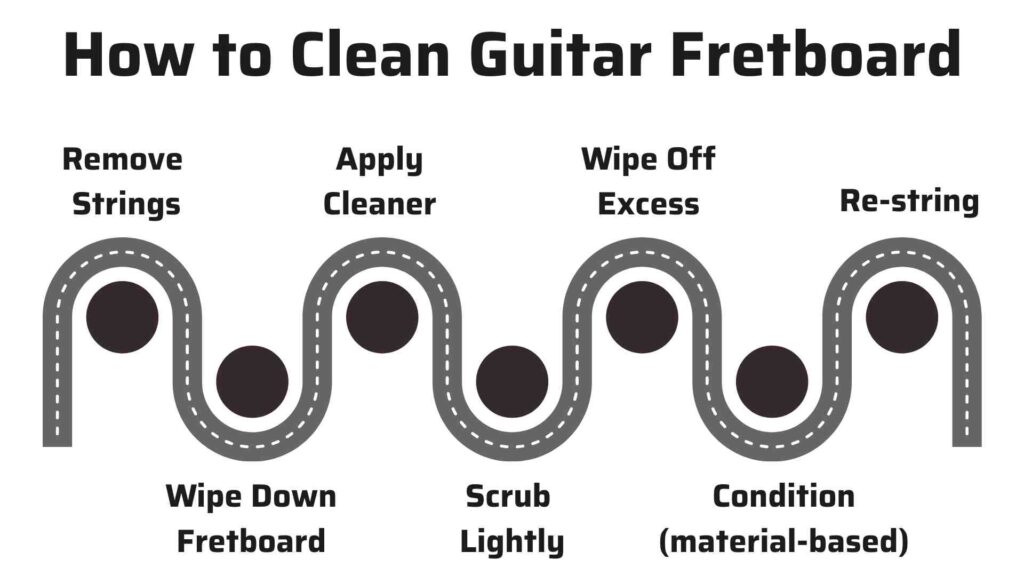
Step 1: Remove The Strings
First, loosen the guitar strings to take them off.
Turn the tuning knobs counterclockwise of each string to remove. This loosens the wires and gives you full access to the fretboard. That way, you can clean it well.
Use a string winder or do it by hand to remove the strings. Make sure you do it safely without damaging the instrument.
Tips:
- Place your guitar on a stable surface.
- Make sure the back is facing up.
- Use a soft cloth or towel underneath.
This will protect the finish from scratches.
Step 2: Wipe Down the Fretboard
You’ll need another cloth for this.
- Use a microfiber cloth.
- Wipe the surface in the direction of the wood grain.
This should remove the fretboard. Plus, it polishes the frets.
Make sure the rag is soft, lint-free, clean, and dry.
Some debris can be hard to clean. In that case, the rule is always the same—
- Gentle pressure for the loose dirt
- Light-to-medium amount of pressure for the stubborn one
Don’t apply too much pressure. Heavy scrubbing and moving the body aggressively can damage both the fretboard and the guitar.
You can use a toothbrush or cotton to clean the corners and tricky areas, especially around the ridges.
Tips:
- Avoid getting into the electronics and finish.
- Cover pickups with masking tape for electric guitars otherwise it may attract lints.
Step 3: Apply Fretboard Cleaner
Use a cleaner on the fretboard.
The amount would vary based on the wood materials. For instance—
| Fretboard Material | Finish | Amount | Frequency |
| Rosewood, Ebony, Pau Ferro | No | A few drops on a microfiber cloth | 2-3 times a year |
| Maple and Richlite | Yes | Lightly dampen the cloth | As needed, or after each use |
Wood cleaners help clean the fretboard thoroughly. They usually have solvents and degreasers.
These compounds break down stubborn grime and oils that pile up on the fretboard.
You can use commercial products like Jim Dunlop and MusicNomad. Don’t use home remedies like baking soda to clean wood. This can weaken the material and cause damage.
Step 4: Scrub Lightly with a Brush
It’s scrubbing time now.
Use a soft-bristle brush for the job. Apply light pressure to scrub the fretboard gently with it. Focus on the areas like around the frets where dirt can easily accumulate.
This will help lift any grime that can get stuck there without causing any scratches or damage.
Step 5: Wipe Off Excess Product
After that, wipe the fretboard again. Get a clean, dry microfiber cloth.
Use it to wipe off any leftovers— cleaner, oil, or dirt.
This ensures all grime is fully removed. And you get a clean surface.
Step 6: Apply Fretboard Conditioner
If your guitar has an unfinished fretboard, then we suggest using conditioner.
Materials without finish like Rosewood, Ebony, and Pau Ferro can dry out over time and end up with cracks. Conditioning helps prevent both through common elements like solvents and oils.
- Use 3 to 5 drops of conditioner. Lightly rub and wipe off excess.
- Condition the fretboard at least 1-2 times a year.
Conditioners like lemon oil and citrus oil can work wonders. Both help take off dirt and condition the wood surface to maintain the finish of the material.
Such conditioners help nourish the wood most effectively. They strengthen the physical structure, prevent cracks, enhance the wood’s natural grain, and smoothen the surface to improve playability.
Step 7: Re-String the Guitar
Check if the old strings are in good condition.
If they are, put them back.
In case, they have issues, use a fresh set of strings and re-string the guitar.
Some common signs of bad strings are–
- Dull or tarnished look
- Corrosion
- Rough or stiffen up
- No initial sparkle
- Dull sound– buzzing and rattling
- Kinks
- Discoloration
Read this article to know how you can restring the guitar.
How Often Should You Clean Your Guitar Fretboard?
Dirt, sweat, and oils easily build up on the fretboard over time. Hence, you should clean the fretboard whenever required.
Manufacturers like Zager recommend cleaning the fretboard every 2-6 months depending on frequency.
- Play heavily or daily? Then clean the guitar fretboard every 1-2 months.
- Play occassionally? Then, clean the fretboard every 3-6 months.
You can also clean the fretboard whenever you change the strings.
However, wood can easily attract dust. So, try to wipe off the dust particles with a dry cloth regularly to prevent further issues.
If not regularly, then once a month would suffice.
Also, pay attention to the overall condition of the fretboard. Watch out for any changes:
- Stickiness
- Discoloration
- The buildup of grime
These signs tell you it’s time to clean the fretboard.
Seasonal changes can impact your fretboard too.
During dry or cold months, clean and moisturize the fretboard more often to prevent cracking. Around every 1-2 months.
If it’s humid, you may need less frequent cleaning.
What to Avoid When Cleaning Your Fretboard?
Harsh Chemicals
The worst enemy of your guitar.
Never use household cleaners on your fretboard. Be it alcohol or furniture polish.
Such products have harsh chemicals like
- Silicone
- Carnauba waxes
- Paraffin waxes
They can strip the natural oils from the wood and cause long-term damage.
Water Exposure
Water is a tricky friend of wood.
Such a material tends to be hygroscopic. It easily absorbs and desorbs water from the surroundings.
While desorbing leads to dryouts and cracks, absorbing causes unique problems.
Excess water and moisture in the wood can warp the fretboard. It changes the entire shape of your instrument. Moreover, moisture absorption in the fretboard wood causes different problems like–
- Swollen fretboard
- Glue weakening
- Weird tone
- Uneven string tension
- Buzzing and mutings of strings
- Too high string action
- Misaligned bridge
- Sticky-like finish
So, don’t expose the fretboard or guitar to too much water. Don’t clean it by soaking a cloth in water. Better to use a damp rag.
Abrasive Materials
Some tools should be there for certain purposes.
For instance, abrasive or harsh scrubbing materials like steel wool can be a bad idea. It’s because they can cause–
- Damage
- Wood splinters
- Discoloration
- Scratches
This happens when you scrub aggressively or too often. You don’t need them for loose debris.
Instead, use steel wool of 0000 to clean the fretboard. It should only be used in circumstances like–
- Severe grease and grime buildup
- Unfinished wood upkeep
Additional Tips for Maintaining Your Guitar Fretboard
Use Fretboard Guards
These guards are shields that protect your guitar fretboard from scratches and damage as you clean the parts.
Know About Fret Guard Material
Usually, fingerboard guards come in metal like stainless steel or plastic. Both have pros and cons.
Metal Fretboard Guards
- Strengths: Solid and offer better protection when cleaning.
- Weaknesses: Heavy. This can cause scratches if not handled carefully.
Plastic Fretboard Guards
- Strengths: Very lightweight and easy to handle. So, less likely to scratch the fretboard.
- Weaknesses: Not very durable. Can break easily.
Choose The Right Size
Pick the guard as per the size of your frets and fretboard.
Fretboard shields come in different sizes. Producers have designed each for different fret sizes. Guitar sets mainly have narrow, medium, and wide slots.
Typically, the standard radius can go from 7 to 16 inches.
So, check their size and get the guards accordingly.
Hold The Guards In Place
Most of the fret shields have rubber bands. You can use those bands to hold them in place. The process goes like this–
- Loop the band around the neck.
- Fasten in the notches on the guard.
This helps free up your hands so you can work on the fretboard and clean it.
Store Your Guitar Properly
Put your guitar away the right way. Look for the best spots to keep your friend safe.
Keep Environmental Conditions in mind.
Higher temperatures can warp and weaken the tonewood and fretboard wood of the guitar. The result– cracks.
So, store it somewhere cool– not freezing.
For guitar storage, Most manufacturers like Mr. Zager says–
- Ideal Temp— 66 to 77°F
- Ideal Humidity— 40 to 50%
This helps keep the instrument in fine condition. Plus, it maintains the wood’s moisture level.
Try to protect the guitar from dust and rain. Use a case made of hardshell materials like— fiberglass, injection-molded, and wood.
Our Zager Guitar Cases are extremely durable. One comes in a Hard Shell and one is ABS Molded.
They promise to keep your guitar and fretboard safe.
Check out our extensive blog here to get some more Guitar Storage Ideas.
Best Tools To Clean Your Guitar Fretboard
- Fretboard Cleaner
- Soft Microfiber Cloth
- Soft-bristled Brush
- 0000 Steel Wool (depends)
- Fretboard Conditioner and Oil
Things To Remember
- Don’t clean the fretboard improperly.
- Don’t leave the fretboard uncleaned for too long.
- Don’t forget to clean or replace the strings (if damaged).
- Make sure to properly remove the strings before cleaning.
- Avoid extreme temperatures and external elements.
- Don’t overclean a fretboard as it weakens the wood and causes damage.
- Avoid using unnecessary and suspicious home remedies.
- Don’t leave your guitar out there.
Frequently Asked Questions
There will be some symptoms that tell you it’s time to clean your fretboard. For instance–
– Sticky surface
– Grimy
– Visible dirt and buildup
– Discoloration
Yes. Use string spreaders to keep the string out of the way and clean the fretboard without taking off the strings.
Grab some fretboard-specific oils like lemon oil or linseed oil to condition your guitar fretboard. However, get one based on the wood type.
The finished fretboard doesn’t require conditioning.
No. Lemon oil isn’t safe for certain fretboards like maple and Richline, especially when they come with finishes.
Safely use lemon oil on fretboard materials like unfinished ebony, rosewood, or wenge.
Give Your Fretboard A Clean Look!
You must clean your fretboard whenever you see any changes. It can be anything–
- Dirty look
- Stickiness
- Discoloration
If you keep being careless, it’ll affect the tonal quality, feel, and performance of the guitar. Plus, the strings will get stiffer and you can’t play it well.
So, give your fretboard a good look by cleaning it well. This doesn’t mean showering it. Instead, use a lightly moistened cloth with a bit of cleaner on it to clean it. If it’s an unfinished fretboard, condition it afterward.
Regular upkeep will help keep your fretboard free of dirt and damage.
